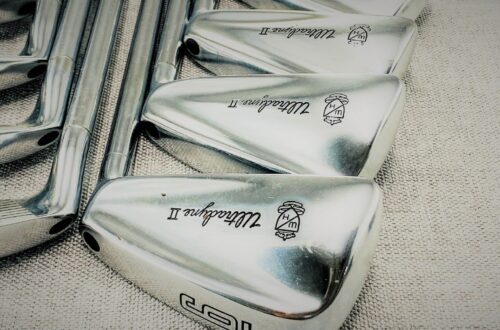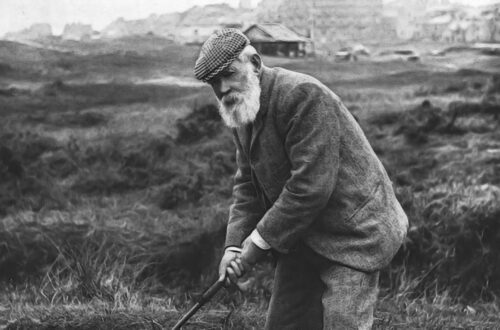Kelly Leonard Long-nose Brassie
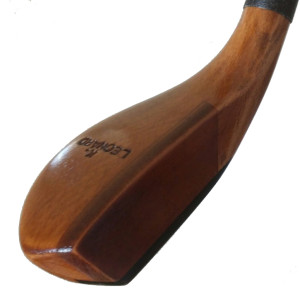 As I worked to assemble an authentic 1890s playset, I was fortunate to have the chance to borrow a set of quality clubs from Chris McIntyre before I set out to purchase my own equipment. In Chris’ loaner set were some lovely heavy irons – all originals – with wide, suede grips and one curious replica long-nose spoon, marked T. Morris Model, which I later learned was a club made by Tad Moore for a few years, but since discontinued.
As I worked to assemble an authentic 1890s playset, I was fortunate to have the chance to borrow a set of quality clubs from Chris McIntyre before I set out to purchase my own equipment. In Chris’ loaner set were some lovely heavy irons – all originals – with wide, suede grips and one curious replica long-nose spoon, marked T. Morris Model, which I later learned was a club made by Tad Moore for a few years, but since discontinued.
Chris shared this set with me, along with some gutty balls and an Oakmont ball, so that I could learn to appreciate the true experience of 1890s gutty golf, not merely the act of using “transitional” 1900s smooth faced clubs with a modern golf ball. That, I have to say, also has its merits and is a joy to experience, but the long-nose, heavy irons from the forge are unique to themselves, and once I tried it, I was determined to collect a set of my own.
While so many of we hickory enthusiasts strive to use authentic antiques in our play, the one area where this is generally ill-advised is with antique long-nose playclubs, due to their relative value and potential for irreparable damage. This is not to suggest that there are none in play, but having questioned many players who participate in SoHG gutty events, I have confidence in stating that a great many employ replica woods for the reasons stated.
My immediate response to using 1890s clubs with a gutta ball (or replica gutta ball) was utter fascination with the flight of the ball itself. I found shots moving in full draw mode that transformed, mid-flight, into fades. This wasn’t uncommon. In fact, it is the norm.


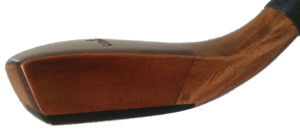
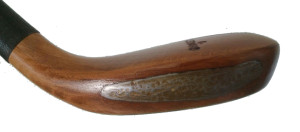 I tend to enjoy hitting balls hard when I play. It is not easy for me to scale back to 80% and simply enjoy steady play. (I have played a fair amount with Mike Just and will always picture in my mind his languid swing and subsequent strolls right down the center of every fairway.) In my 40s, this doesn’t suit my fancy. I like to get after it and have yet to learn to play the total finesse game, I admit.
I tend to enjoy hitting balls hard when I play. It is not easy for me to scale back to 80% and simply enjoy steady play. (I have played a fair amount with Mike Just and will always picture in my mind his languid swing and subsequent strolls right down the center of every fairway.) In my 40s, this doesn’t suit my fancy. I like to get after it and have yet to learn to play the total finesse game, I admit.
Smash factor isn’t really suitable with really old antique clubs. So playing with my Carricks, 1890 Forgans, 42-inch-handled cleeks and rut niblicks is teaching me to “sweep” more balls to generate the best results. It’s an angle of the game one can truly learn to love; especially upon seeing semi-effortless swings produce shots in the 170-yard range that move straight toward the target. I’ve been playing my old clubs most of this summer, and love them as much as my 1915 clubs now. But they are totally different and require a completely different approach to the game.
Chris had this lovely, stout, somewhat short, Tad Moore long-nose spoon in his set, which I offered on more than one occasion to buy (no deal, he said!). To me, it was like swinging a bulldog (with its associated control and stiff feel as a result of the shorter shaft), but with an added element of mystery as the crescent-shaped club face produced magical trajectories on some shots and wild hooks on others. Wow, it was fun to hit, and with a short handle on it, I was able to play (or swing) almost as hard as I wished, knowing that it would stand up to the test. It is a replica, after all.
But, alas, while I was able to find exceptional period irons (most from a dealer in Pinehurst), acquiring a wood playclub proved to be the most difficult challenge for me. Many were simply too expensive and I had little to no opportunity to handle these as I considered such an investment.
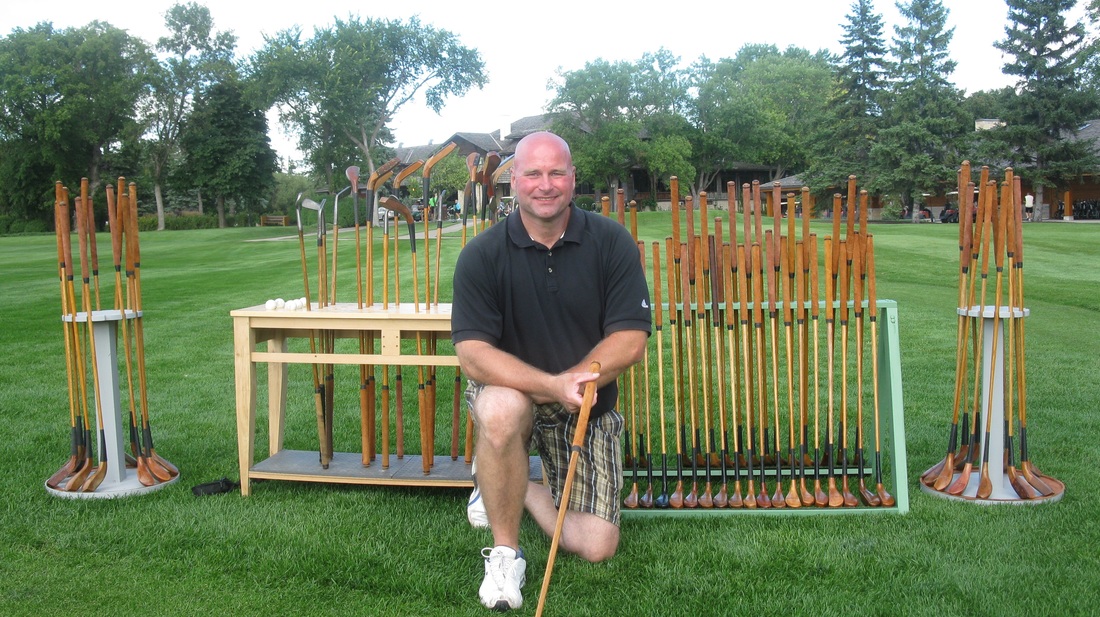 Chris turned me on to a maker in Canada who, in spite of my very extensive research online and hours of trolling sites in the UK, Germany and elsewhere for clubs, I had never heard of nor found any reference to, curiously. I came to learn that Chris has been advising this woodworker for several years, and he has produced, during this time, an astonishing array of clubs. His name is Kelly Leonard.
Chris turned me on to a maker in Canada who, in spite of my very extensive research online and hours of trolling sites in the UK, Germany and elsewhere for clubs, I had never heard of nor found any reference to, curiously. I came to learn that Chris has been advising this woodworker for several years, and he has produced, during this time, an astonishing array of clubs. His name is Kelly Leonard.
Chris put me in touch with Kelly, and I found his website to be an inspiration. He has documented much of his work, and there are tremendous examples of his creations through the years. This excited my confidence and I immediately ordered one of his 2015 brassies, without a second thought. I’m now grateful that I did, and I am more than happy to endorse his work.
Kelly has been making clubs since 2005 – mainly for outings and for use with period-appropriate balls.
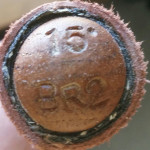
As his website states, “Every club I build has a resemblance of the way the old club makers would have built them. They are built individually from each golf head right up to the hickory shaft. I cut my own leather grips, install horn slips and add molten lead to each club to bring it up to weight. I shape each shaft using a spokeshave and shaving horse (and I have the shavings to prove it). Finally, every club gets a minimum 10 coats of shellac.
My clubs are meant to be played with a gutta percha golf ball. The putter is the only exception, it can be used with any type of golf ball.
Every club I build is for sale or rent. In 2012, I had the privilege bringing the clubs out to two tournaments. The old hickories and gutties were used on one hole from tee to green. They were both amazing events. Most everyone who participated seemed to enjoy having the clock turned back some 130 years.”
Kelly is a professional woodworker who creates his clubs from oak, beech, pear, and more. He’s been making brassies, spoons, putters, play clubs with wood and leather inserts, and has photos of his blocks, in process, which makes for interesting viewing. My brassie has a boiled leather face insert and I opted to not have brads placed through it, as I prefer the clean look.
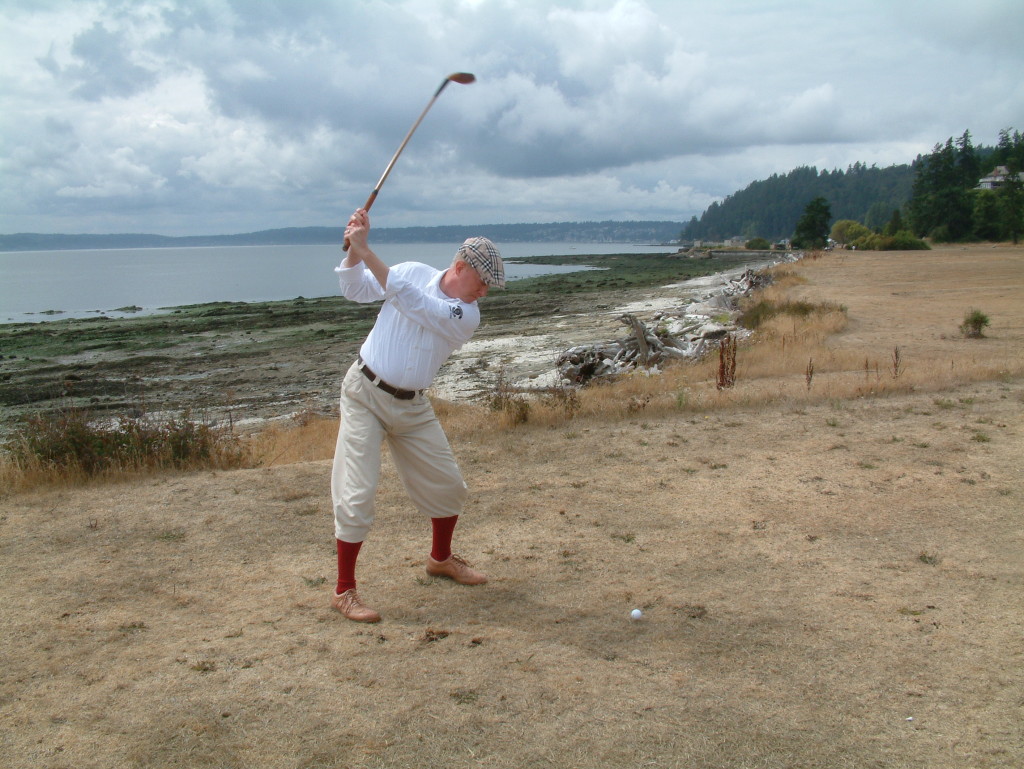 I’ve been playing his long-nose brassie (BR2) all this summer (2015) and as it is considerably longer in length than the Tad Moore Spoon (the Brassie is about 43 inches), it forces me to slow down my tempo and it produces a really nice, consistent draw for me. I’m a player that tends to hit more heel shots in my common swing pattern. I find these long-nose clubs are more forgiving in that sense, and I love the ample room for variation in strike zones the heads allow.
I’ve been playing his long-nose brassie (BR2) all this summer (2015) and as it is considerably longer in length than the Tad Moore Spoon (the Brassie is about 43 inches), it forces me to slow down my tempo and it produces a really nice, consistent draw for me. I’m a player that tends to hit more heel shots in my common swing pattern. I find these long-nose clubs are more forgiving in that sense, and I love the ample room for variation in strike zones the heads allow.
With a really solid connection, I’m getting about 180 with this club, max. I play one tee box up with my 1890s clubs, and it tends to level the playing field vs. “modern” hickories (pre-1935). I’ve been playing with several balls with my 1890s clubs, including the Ouimet mesh-pattern replica ball, the Park line-cut replica ball, and the Wilson Duo Spin which has a 39 compression rate.
I told Kelly that I would help spread the word about his wonderful work. I’m happy to encourage you to visit his website and I thank Mr. McIntyre for making me an advocate of the auld golf approach. It only deepens my affection for this sport (although I need to find appropriate trousers for my outings! They didn’t wear plus-twos or fours back then! Shame on me.) I plan to play this winter with my Norfolk jackets…
– Rob Birman






